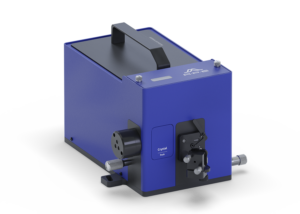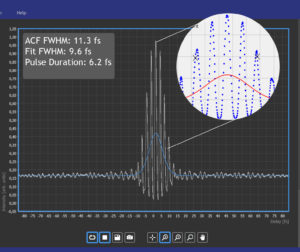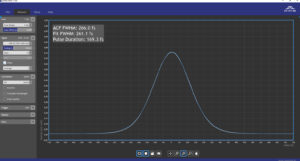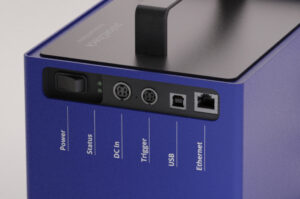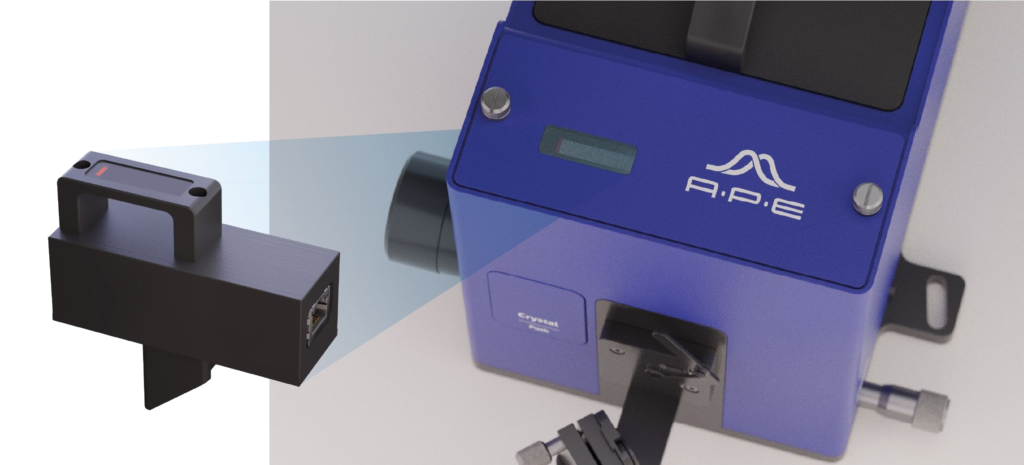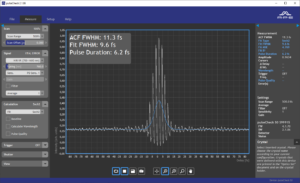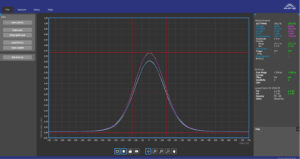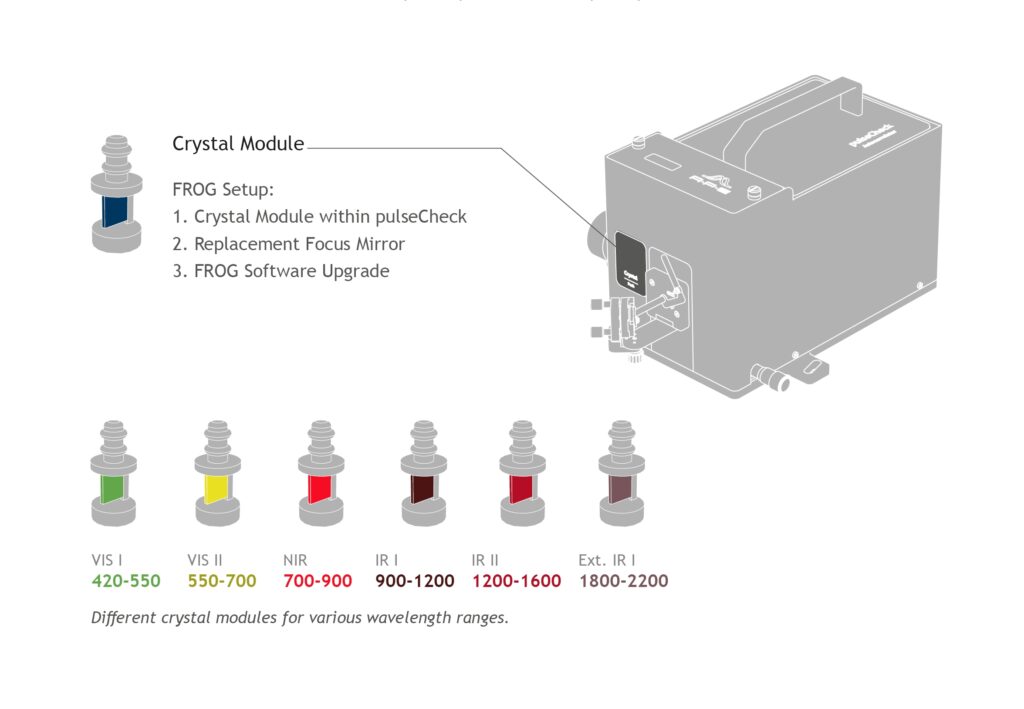pulseCheck NX
In 2022, APE launched the pulseCheck NX, the latest generation of the well-known pulseCheck autocorrelator.
Here we would like to introduce the main new features of this pulseCheck generation.
What is new compared to previous pulseCheck models?
Integrated, data analysis at high resolution
New Software with Intuitive User Interface
In the pulseCheck NX, all the data analysis is performed on an integrated, advanced system-on-chip based architecture. This design enables autocorrelation measurements with low latency and a high resolution down to 50 attoseconds. Furthermore, the exceptional intensity dynamic range of 18 bits allows full access to even the tiniest autocorrelation features.
The pulseCheck NX software has a user-friendly interface with an intuitive layout. It allows you to focus on relevant data and gives easy access to built-in data analysis. The high-contrast mode option of the graphical user interface (GUI) enables great visibility when using laser safety glasses.
The pulseCheck NX software comes with comprehensive data analysis tools. Integrated fitting algorithms make it easier to evaluate your data. Operational settings and previously acquired data can be displayed simultaneously to provide context and reference for current measurements.
Plug & Play and Easy Integration with Network Interface
Automatic Phase Matching
The pulseCheck offers easy-to-use plug & play capability via Ethernet or USB connection. In addition, the pulseCheck can be easily integrated into automated test and measurement environments via SCPI commands over TCP/IP. All this is possible without the need for an additional PC, since all the data acquisition and data analysis is perform inside the device. The pulseCheck can also be controlled directly from any location via a network connection.
Autocorrelators take advantage of phase-sensitive and nonlinear processes and require what is called phase matching. To achieve optimal phase matching for the specific wavelength, you would normally have to adjust manually the phase matching meaning the autocorrelator crystal angle. In contrast, the APE pulseCheck NX obtains the phase matching software aided via a factory-set calibration for each wavelength, resulting in precise and fast operation without the need for manual adjustment.
Measurements are made even easier by using our TPA detectors, which combine detector and nonlinear optics in a single element. Here, phase matching adjustments are no longer necessary at all.
Proven Features of pulseCheck Series
Optics and Detectors for UV to MIR (200 nm … 12 µm)
From Ultrashort to Longer Pulses (5 fs … 500 ps)
The pulseCheck autocorrelators can cover the broadest wavelength range available on the market. This feature is achieved, via multiple detector types and optics sets which can be easily exchange due to the highly modular pulseCheck design. For example, photomultiplier (PMT) detectors are highly sensitive and are ideal for pulse measurements at low pulse energies with high repetition rates. In contrast, for low repetition rate measurements, typically photodiode detectors (PD) and TPA detectors are better suited. Our experts will support you with the right detector selection. In combination with highly efficient optics, our detectors pave the way for measurements over a wide wavelength spectrum from 200 nm to 12 μm.
Various pulseCheck configurations can be adapted to the individual needs of pulse duration measurement. For example, the pulseCheck NX 50 allows ultrashort pulse measurements from 5 fs to 15 ps pulse duration, while the measurement of extra-long pulse durations up to 500 ps is possible with pulseCheck SM 2000.
Collinear and Non-Collinear Measurements
NIST Traceable Calibration
Our autocorrelators support easy adjustment between collinear and non-collinear measurement modes. The collinear mode – often referred to as interferometric or fringe-resolved mode – provides additional qualitative information about the chirp and the central wavelength of the pulse.
In contrast, the non-collinear mode – also referred to as intensity autocorrelation – provides background-free, high dynamic range autocorrelation.
An important requirement for quality assurance systems is the traceability of a measuring instrument to international or national standards. For this reason, all APE autocorrelator models are calibrated to a traceable standard according to NIST specifications (NIST = U.S. National Institute of Standards and Technology).
Each pulseCheck comes with a printed and signed calibration certificate. The calibration can of course be renewed at our premises or by a certified partner at any time.
After Sales, Add On Capabilities of every pulseCheck
Easy Wavelengths and Sensitivity Extension
Fiber Coupling of Input Beam
APE offers a wide range of easily exchangeable Optics Sets for the pulseCheck NX autocorrelators. This modular design allows the spectral coverage from 200 nm up to 12 µm and enables different detector sensitivities according to the customer needs (PMT, PD and TPA detectors). Optics Sets for an already acquired pulseCheck NX can easily be bought later in order to upgrade the originally specifications.
APE offers a wide range of easily exchangeable Optics Sets for the pulseCheck NX autocorrelators. This modular design allows the spectral coverage from 200 nm up to 12 µm and enables different detector sensitivities according to the customer needs (PMT, PD and TPA detectors). Optics Sets for an already acquired pulseCheck NX can easily be bought later in order to upgrade the originally specifications.
FROG Option Possibilities
Links
Second Harmonic Generation FROG (Frequency Resolved Optical Gating) is probably the most popular method to measure the spectral and temporal phase of an ultrashort laser pulse giving access to complete pulse characterization. APE pulseChecks NX can be equipped with FROG Optics Sets, enabling FROG as well as autocorrelation measurements within the same device. The customer can change easily between both measurement techniques by exchanging the respective detectors and Optic Sets via magnetic holders.
Check out our new Quick Installation Guide, highlighting the easy and quick unpacking software installation and beam adjustment in just 9 simple steps.
pulseCheck NX specifications
pulseCheck NX datasheet

